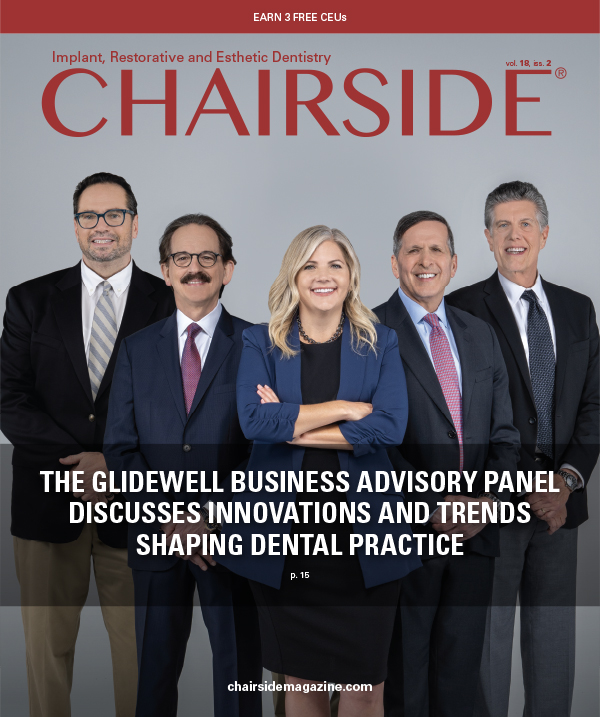Letters to the Editor
Dear Dr. Resnik,
In your article “Socket Grafting: When to Graft and What to Use” (Chairside® magazine, Vol. 18, Iss. 1) you recommend addressing thin five-walled defects with an allograft blend and a Newport Biologics™ Resorbable Collagen Plug cut in half and hydrated with 0.9% sodium chloride. Is it also recommended to use a membrane instead of a collagen plug?
DDS,
Bend, Oregon
Dear Doctor,
Membranes can be used in a wide range of grafting situations. I chose a resorbable collagen plug for this particular case because it is a faster-resorbing collagen (10–14 days). A plug extends the collagen underneath the reflected subperiosteal pouch, increasing retention. They are ideal for five-walled defects with thin bony plates (less than 1.5 mm) that require hemostasis and graft containment.
When addressing small- to medium-sized bony defects, a longer-acting collagen can be used, like a Newport Biologics Resorbable Collagen Membrane. These membranes are available in two different resorption schedules: 3–4 months and 4–6 months.
While each case is different, membranes are commonly used in grafting procedures due to their useful characteristics:
- Tissue compatibility
- Space maintenance
- Stabilization of the blood
- Mechanical strength
- Predictable resorption rate
- Easy to modify and manipulate
In general, the larger the socket, the longer-acting the membrane should be for that site.
Sincerely,
Randolph R. Resnik, DMD, MDS
Dear Dr. Park,
I enjoyed reading the article in the last issue (Chairside magazine, Vol. 18, Iss. 1) with Dr. Taylor Manalili called “The Implant-Retained Mandibular Overdenture.” Are there any online courses I can take to learn more about this topic?
DDS,
Memphis, Tennessee
Hello Doctor,
If you want to learn more about implant surgery — as well as many other topics in clinical dentistry — you can look at our on-demand courses online at glidewell.com/education/courses/online-courses. We currently have over 30 courses on implant restorations and surgery that are taught by experienced clinicians. Plus, each course offers continuing education units. Additional online education opportunities include previous editions of Chairside magazine, the Glidewell Online Study Club and videos on over 40 dental topics. And we would love to see you at some of our in-person education offerings too. Sign up for a live course or even one of our many symposia for a chance to learn with your colleagues and grow your clinical skills.
Regards,
Neil Park, DMD
Dear Dr. Bender,
I read the 2023 BruxZir® Zirconia update that was included in the last issue of Chairside (Chairside magazine, Vol. 18, Iss. 1). Because BruxZir Esthetic Zirconia is highly recommended for restorations in the smile zone, I am interested in using the material for anterior veneers. Can BruxZir Esthetic be bonded for veneers?
DMD,
Dallas, Texas
Yes! BruxZir Esthetic restorations can be reliably bonded with the help of three steps: decontamination, air abrasion and MDP priming (10-Methacryloyloxydecyl dihydrogen phosphate). Because Glidewell completes the etching and air abrasion steps at the lab, the dentist only needs to decontaminate and prime the restoration prior to bonding.
Decontamination is vital in order to produce a strong bond between the preparation and the restoration. After initially trying in the restoration, the clinician must properly treat the intaglio surface by removing any possible salivary phosphates. Two materials you can use include:
- Ivoclean (Ivoclar Vivadent, Inc.; Amherst, N.Y.).
- 1 percent sodium hypochlorite.
Once the BruxZir restoration is decontaminated, the MDP-containing primer can adhere. Primers like Monobond Plus® (Ivoclar Vivadent, Inc.; Amherst, N.Y.) will chemically adhere to zirconia. Then, the restoration is ready for cementation. I prefer to use NX3 Nexus™ Third Generation cement (Kerr Corporation), which allows the clinician great working time to position the veneers.
For more detailed instructions on the preferred protocol for bonding BruxZir Esthetic veneers, read Dr. Justin Chi’s “Letters to the Editor” response in Chairside magazine Vol. 14, Iss. 1.
Best,
Jinny Bender, DMD




